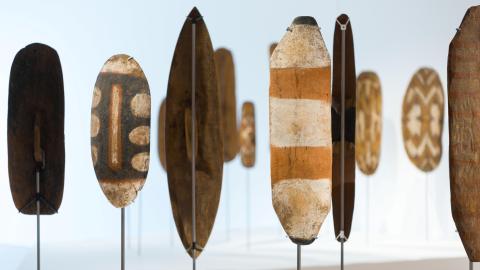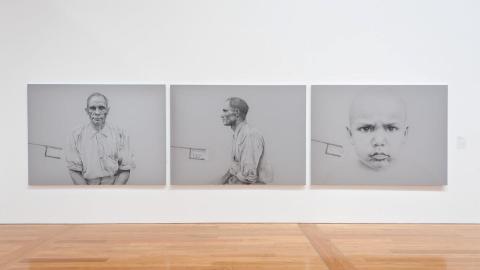ESSAY: ‘I, Object’
By Bruce Johnson McLean, Adam Ford
‘I, Object’ August 2019
For hundreds of years, traditional Indigenous objects have been coveted by collectors and treasured by audiences for their aesthetic potency and the richness of their forms. For First Nations peoples, these objects carry a powerful cultural load and are considered akin to family or a part of themselves — physical, tangible products of cultural inheritances integral to their personal and collective identities. A tremendous source of pride and inspiration, these cultural objects are considered by many to be ancestors. Throughout the world, natural history museums hold important Indigenous cultural materials that are dislocated from their origins. The multi-generational holdings in public and private collections, combined with the restriction and cessation of many associated cultural practices, is a great source of cultural loss and trauma. In contrast to natural history museums, art galleries — including QAGOMA — have become important sites in which First Nations peoples can exercise greater agency over how their communities and works are presented. In art galleries, Indigenous cultural materials are often regarded as living objects rather than antiquities, belonging to ongoing cultural traditions and practices.

A view of ‘I, Object’, featuring Queensland shields dated c.1880s–1900s by unnamed ancestors, GOMA, January 2020 / Purchased 2021 with funds from the Neilson Foundation through the QAGOMA Foundation / Photograph: N Harth, QAGOMA
Through juxtapositions of historical objects and works by contemporary artists, ‘I, Object’ considers the complex relationships Indigenous Australian artists have to cultural objects — from the histories informing their creation to the social and cultural consequences of their collection. A major installation of traditional Queensland shields highlights the strength and diversity of cultural and artistic traditions from across the state. These shields, their histories and inheritances are paired with recent works referencing original shield-making practices and illustrate the impact of Western aesthetics and colonial policies on Indigenous peoples and society. Additionally, the body-as-object is also considered within this exhibition. Throughout the world, the collected human remains of Aboriginal and Torres Strait Islander ancestors — items numbering in the thousands — are housed in museums. Here, works that speak to the sordid histories behind this type of collecting are shown alongside works that both witness and critique the continued consumption of Indigenous bodies, images and identities — from archival memorial plaques to romanticised images of Aboriginal peoples emblazoned on ashtrays. Together, these contemporary works and artists are helping to reshape the ways in which we understand and relate to cultural objects, and the history of Indigenous objectification itself.

A view of ‘I, Object’, featuring Queensland shields dated c.1880s–1900s by unnamed ancestors, with Michael Boiyool Anning’s Rainforest shield (pond skater design) and sword 2000–01 visible in the background, GOMA, August 2019 / Collection: QAGOMA / © Michael Boiyool Anning/Copyright Agency / Photograph: N Harth, QAGOMA
Of all the traditional Aboriginal objects, shields are one of the most heavily collected. Large, portable, and often richly decorated in customary clan designs, shields were popular with anthropologists, ethnographic collectors and everyday frontiersmen. For many Aboriginal groups, following the dual blows of colonisation and Christianisation, countless artistic shield traditions and inheritances were devastated. Today’s shields contain some of the best records of regional Aboriginal mark-making and artistic traditions, and are typically replete with elaborate designs and patterning. This major installation of Queensland shields demonstrates just a few of the many and diverse shield producing and mark-making traditions from across the state. Most of these shields are from central through to southern Queensland where they are widely known as Gulmari (Goomeri, Gulmardi). Gulmari are oval to almost rectangular in form and often feature bold and blocky relief carved geometric designs. A group of larger shields show the cultural and artistic heritages of the north-Queensland rainforest. These imposing shields are made of soft fig tree buttresses and were traditionally used to absorb the blows of long hardwood swords in ritual combat. Rainforest shields often feature bold abstracted totemic designs from particular groups or areas within the rainforest and many are still identifiable today. Other shields here represent the traditions of western Cape York, the Gulf of Carpentaria, Mornington Island, and western Queensland. Traditionally used as objects of ritual protection, these shields have protected and preserved many of the state’s Indigenous artistic heritages and inheritances for over one hundred years and will be an invaluable source of cultural knowledge for generations to come.
Essay (2019) by Bruce Johnson McLean (Wierdi people, Birri-Gubba Nation), former Curator of Indigenous Australian Art, QAGOMA, with updates (2023) by Adam Ford (Nyoongar), Assistant Curator, Indigenous Australian Art, QAGOMA.
Feature image: Alair Pambegan / Wik-Mungkan people / Australia QLD b.1966 / Kalben (detail) 2016–17 / Carved wood with synthetic polymer paint and natural pigments, raffia / Purchased 2017. QAGOMA Foundation / © Alair Pambegan

